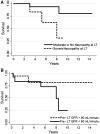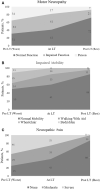Liver Transplantation for Acute Intermittent Porphyria
- PMID: 33259654
- PMCID: PMC8248103
- DOI: 10.1002/lt.25959
Liver Transplantation for Acute Intermittent Porphyria
Abstract
Recurrent attacks of acute intermittent porphyria (AIP) result in poor quality of life and significant risks of morbidity and mortality. Liver transplantation (LT) offers a cure, but published data on outcomes after LT are limited. We assessed the pretransplant characteristics, complications, and outcomes for patients with AIP who received a transplant. Data were collected retrospectively from the European Liver Transplant Registry and from questionnaires sent to identified transplant and porphyria centers. We studied 38 patients who received transplants in 12 countries from 2002 to 2019. Median age at LT was 37 years (range, 18-58), and 34 (89%) of the patients were women. A total of 9 patients died during follow-up, and 2 patients were retransplanted. The 1-year and 5-year overall survival rates were 92% and 82%, which are comparable with other metabolic diseases transplanted during the same period. Advanced pretransplant neurological impairment was associated with increased mortality. The 5-year survival rate was 94% among 19 patients with moderate or no neuropathy at LT and 83% among 10 patients with severe neuropathy (P = 0.04). Pretransplant renal impairment was common. A total of 19 (51%) patients had a GFR < 60 mL/minute. Although few patients improved their renal function after LT, neurological impairments improved, and no worsening of neurological symptoms was recorded. No patient had AIP attacks after LT, except for a patient who received an auxiliary graft. LT is a curative treatment option for patients with recurrent attacks of AIP. Severe neuropathy and impaired renal function are common and increase the risk for poor outcomes. If other treatment options fail, an evaluation for LT should be performed early.
Copyright © 2020 The Authors. Liver Transplantation published by Wiley Periodicals LLC on behalf of American Association for the Study of Liver Diseases.
Figures




Comment in
-
Expanding Experience With Liver Transplantation in Acute Intermittent Porphyria.Liver Transpl. 2021 Apr;27(4):477-478. doi: 10.1002/lt.25979. Epub 2021 Feb 12. Liver Transpl. 2021. PMID: 33369869 No abstract available.
References
-
- Elder G, Harper P, Badminton M, Sandberg S, Deybach JC. The incidence of inherited porphyrias in Europe. J Inherit Metab Dis 2013;36:849‐857. - PubMed
-
- Puy H, Gouya L, Deybach JC. Porphyrias. Lancet 2010;375:924‐937. - PubMed
-
- Lenglet H, Schmitt C, Grange T, Manceau H, Karboul N, Bouchet‐Crivat F, et al. From a dominant to an oligogenic model of inheritance with environmental modifiers in acute intermittent porphyria. Hum Mol Genet 2018;27:1164‐1173. - PubMed
Publication types
MeSH terms
LinkOut - more resources
Full Text Sources
Other Literature Sources
Medical
Miscellaneous

